Your IV access will be prescribed by your healthcare provider. Typically, you will be sent to a local infusion center or out-patient facility to have this placed. Following is a description of the most common types of access.
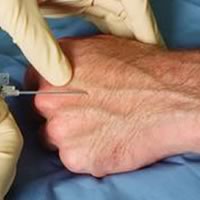 Peripheral IVs are used when the patient requires intravenous access for a short period of time. Peripheral IVs infiltrate easily – they do not last in the vein longer than a few days. They are usually inserted in the hand or forearm and are only about 1 – 1 ½ inches long. They are inserted with a needle covered with a plastic catheter. The needle is removed and the catheter stays in the vein.
Peripheral IVs are used when the patient requires intravenous access for a short period of time. Peripheral IVs infiltrate easily – they do not last in the vein longer than a few days. They are usually inserted in the hand or forearm and are only about 1 – 1 ½ inches long. They are inserted with a needle covered with a plastic catheter. The needle is removed and the catheter stays in the vein.
Central Venous Lines – a central line is a general term for an intravenous catheter whose tip ends in a large blood vessel, usually the superior vena cava, close to the right atrium of the heart. Central lines are used for patients that require IVs for a longer period of time, frequent blood draws, or medications that can be caustic to the smaller veins. After placement, they require an x-ray to make sure the tip is in the proper place. There are several types of central lines, and each has advantages and disadvantages.

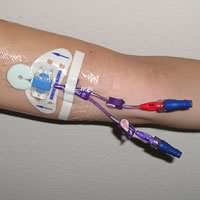 PICC Lines – PICC stands for Peripherally Inserted Central Catheter. This line is typically inserted in the upper arm and is long enough to thread through the veins in the arm to the large vessel that goes into the heart. PICC lines can have a single or multiple lumens. A double lumen line contains two separate openings through the same catheter so that two solutions or medications that are not compatible can be given simultaneously.
PICC Lines – PICC stands for Peripherally Inserted Central Catheter. This line is typically inserted in the upper arm and is long enough to thread through the veins in the arm to the large vessel that goes into the heart. PICC lines can have a single or multiple lumens. A double lumen line contains two separate openings through the same catheter so that two solutions or medications that are not compatible can be given simultaneously.
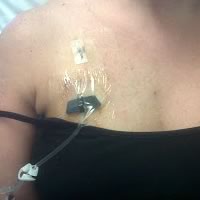
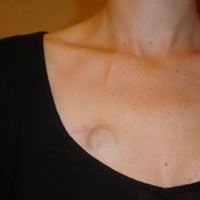
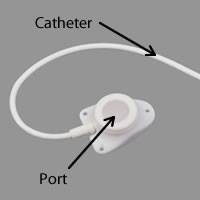 Port (or Portacath) is placed under the skin in the chest and is comprised of two parts – the catheter that ends in the large vein close to the heart and the connected “port” that is usually placed in the chest below the collar bone. This port has a septum that is pierced with a right angled (Huber) needle whenever an infusion of fluids or medication needs to occur. The needle can stay in for a week, or it can come out each time an infusion is finished. The port may be pierced many times without it weakening. When the port in not accessed with a needle, it is unobtrusive, no dressing is required and the patient can swim, shower, etc.
Port (or Portacath) is placed under the skin in the chest and is comprised of two parts – the catheter that ends in the large vein close to the heart and the connected “port” that is usually placed in the chest below the collar bone. This port has a septum that is pierced with a right angled (Huber) needle whenever an infusion of fluids or medication needs to occur. The needle can stay in for a week, or it can come out each time an infusion is finished. The port may be pierced many times without it weakening. When the port in not accessed with a needle, it is unobtrusive, no dressing is required and the patient can swim, shower, etc.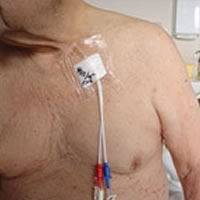
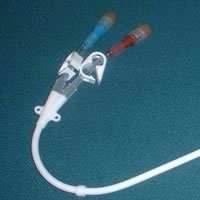 Tunneled Catheter – This is a catheter that is inserted typically in the chest and then threaded through a “tunnel” of tissue until it enters the vein. This helps anchor the catheter. This type of catheter can also have a single or multiple lumens.
Tunneled Catheter – This is a catheter that is inserted typically in the chest and then threaded through a “tunnel” of tissue until it enters the vein. This helps anchor the catheter. This type of catheter can also have a single or multiple lumens.
Other Information
- Sometimes tunneled catheters are called “Hickman” or “Broviac” – this is actually the brand of the catheter, not the type of catheter.
- Power PICCs, Power Ports – these catheters allow a large volume of viscous solution to be infused quickly without rupturing, required for certain diagnostic tests. For general use at home they are treated just like any other catheter.
- All catheters must be flushed periodically either with saline, heparin or both. Generally if ports are not in use, they can be flushed with saline and heparin once/month. Other types of catheters require both saline and heparin at least once/day. Groshong catheters (specific brand, there may be others) do not require heparin although heparin will not hurt them.
- Central catheters are made out of a flexible material and placed with guide wires which are then removed.
